Petra Bohall Wood Tabbed as FNR Distinguished Alumna
 Petra Bohall Wood was really interested in archeology and geology as a child. She loved being outside and had a small vegetable garden, but didn't really grow up interacting with nature. A high school biology course, however, changed the course of her life and marked the beginning of a journey to an impactful career in wildlife science, which has ultimately led to her selection for the 2022 FNR Distinguished Alumna Award.
Petra Bohall Wood was really interested in archeology and geology as a child. She loved being outside and had a small vegetable garden, but didn't really grow up interacting with nature. A high school biology course, however, changed the course of her life and marked the beginning of a journey to an impactful career in wildlife science, which has ultimately led to her selection for the 2022 FNR Distinguished Alumna Award.
"I took high school biology and really loved it; I seemed to gravitate toward natural history," Wood recalls. "So, when I was thinking about what I would do, I knew I wanted to go to college and I heard about this career called forestry, which I really knew nothing about, and I ended up enrolling at Purdue. When I got there and started learning about the different options, I was initially in forest management for a year or two but ended up gravitating into wildlife management. I wasn't a dual major, but I essentially did all of the courses more or less for both forest management and wildlife management.
"Forest management is a huge part of the state and industry in West Virginia, so a lot of my research has focused on forest management and how we influence habitats for various wildlife species, many of which are birds. Having a background in both forestry and wildlife shaped where some of my research questions ended up going in my career, mostly focusing on the effects of human disturbances - timber harvesting and energy development - on wildlife populations, and how land managers can make better-informed decisions on the habitat needs of wildlife."
The Seymour, Indiana, native was active in both the forestry club and The Wildlife Society at Purdue. She got involved in the TWS birding group and developed an affinity for all avian species. Wood's experience was shaped by hands-on wildlife training in labs and identification courses as well as the many giants of the natural resources world who were her professors.
"Time in the lab and also getting out and practicing the things that we were learning, at the Purdue Wildlife Area and at the black walnut experiment at Martell Forest, were impactful," Wood said. "Then we had summer camp down in southern Indiana, and were actually using all of the methods we had learned in class, which was incredible and helpful and made you realize what you were getting into as a career."
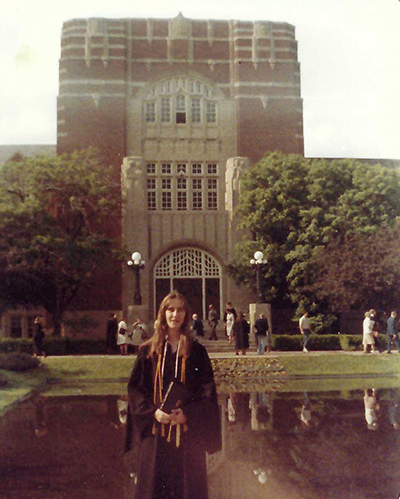 "Dr. Weeks was my undergraduate advisor. He was such a cool guy and he had a really big influence on me, especially because I worked for him for two summers, including one year when I worked on his rabbit project at the Purdue Wildlife Area. Dr. Kirkpatrick was another professor who was a great motivator and mentor to me. I remember working with Dr. Parker on the forestry side of things as a work study, doing some field sampling on one of his projects down in southern Indiana. Professor emeritus Dr. Durward Allen is another person I always remembered. He was a legend and would occasionally come and do some lectures and classes. It was just incredible listening to him and I remember thinking how can someone have all of that information stored away in their brain."
"Dr. Weeks was my undergraduate advisor. He was such a cool guy and he had a really big influence on me, especially because I worked for him for two summers, including one year when I worked on his rabbit project at the Purdue Wildlife Area. Dr. Kirkpatrick was another professor who was a great motivator and mentor to me. I remember working with Dr. Parker on the forestry side of things as a work study, doing some field sampling on one of his projects down in southern Indiana. Professor emeritus Dr. Durward Allen is another person I always remembered. He was a legend and would occasionally come and do some lectures and classes. It was just incredible listening to him and I remember thinking how can someone have all of that information stored away in their brain."
With a wealth of knowledge and experience obtained at Purdue before graduating in 1981 , Wood, who was the first in her family to attend college, decided she wanted to continue her education and go to graduate school. An advertisement for a graduate position at the University of Florida working with American kestrels caught her eye. Her interest in raptors and the chance to live in a different environment than Indiana where she grew up landed her in Gainesville, where she would eventually complete both her master's (1984) and PhD (1992) in wildlife ecology.
The findings of her work with American kestrels included the discovery that the southeastern subspecies had unique habitat requirements not shared by the more common migrant northern subspecies. She and her colleagues at the University of Florida developed American kestrel habitat management guidelines that were adopted by the state and also used in surrounding states. This work also led to Wood assisting Florida Conservation Commission biologists with on-site evaluation of proposed development sites as habitat for the threatened species.
Between her master's and PhD, Wood remained in Florida, and found work on a wading bird project and at the Archbold Biological Station in Highlands County. When her husband, John, had an opportunity to move back to Gainesville, a research technician position working with bald eagles for her former graduate advisor (Dr. Mike Collopy) also came open. Wood served in a wildlife biologist role, doing bald eagle research addressing a variety of research questions to aid the species. Ultimately, she and Dr. Collopy worked her research into a PhD project at the University of Florida and the Florida Cooperative Fish and Wildlife Research Unit.
 The bald eagle reintroduction project sought to investigate if researchers could remove eggs from the nests of the Florida population of eagles, relocate them to a facility in Oklahoma where they would be hatched and raised, and eventually distribute and release them in states with declining populations.
The bald eagle reintroduction project sought to investigate if researchers could remove eggs from the nests of the Florida population of eagles, relocate them to a facility in Oklahoma where they would be hatched and raised, and eventually distribute and release them in states with declining populations.
"Back then there weren't many eagles around the country, they were more or less decimated in most areas, but Florida still had a relatively decent population," Wood explained. "The reintroduction project really helped the eagle population start recovering. Southern bald eagles wouldn't have come back as quickly on their own without some help, so that was a really cool thing to be a part of. It was a huge effort with so many people involved across the region. That was my introduction to working on big collaborative projects, and ultimately I ended up working on several other regional projects to address topics that were broader than local issues."
After completing her PhD on bald eagle fledgling habitat, movements and survival, Wood applied for positions across the country from Arizona to West Virginia, but her experiences with cooperative research in Florida drew her to the West Virginia Cooperative Fish and Wildlife Research Unit. The position also included a teaching role at West Virginia University.
"I ended up picking West Virginia mainly because it was with the Cooperative Research Units program where the focus is on research, but you also have an adjunct faculty appointment at the host university," Wood said. "You have close interaction with graduate students and other faculty so the academic side is there to some extent, but it is not a full-blown academic position. It was a good mix and a good place to end up because there were so many interesting and important research questions I was able to be a part of. One focus of the position is to do research that benefits the state and region where you are located. Your job is to figure out what the research needs are and figure out the funding to make that happen."
Wood's first project stemmed from a conversation with a biologist from the Monongahela National Forest, who mentioned that there was a need to get a better handle on how forests were managed and how that was affecting songbirds. This initial project led to many others that examined ways to make forest management more bird friendly.
The research on the relationship between forest management and bird populations has been critical in providing information to private, state and federal organizations on how various types of timber harvesting affect breeding and post-breeding songbird populations. The research data also contributed to a National Commission of Science of Sustainable Forestry study evaluating the relationships between measures of forest structure and biological diversity.
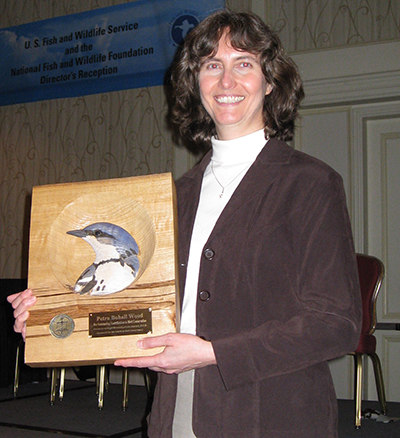 Another project looked at the ecological effects of a coal-mining process called mountaintop removal mining, where surface mining is conducted at the summit or summit ridge of a mountain by removing the land above the coal seams, including tree removal and brush clearance.
Another project looked at the ecological effects of a coal-mining process called mountaintop removal mining, where surface mining is conducted at the summit or summit ridge of a mountain by removing the land above the coal seams, including tree removal and brush clearance.
"The EPA initiated an environmental impact assessment that was evaluating the effects of mountain removal mining on the whole ecosystem," Wood said. "My role in that project for several years was studying songbirds, raptors, small mammals, terrestrial and aquatic salamanders and vegetation. It was a major research effort with many graduate students, research technicians and collaborators comparing the mined and reclaimed landscapes to the original natural forest landscapes and evaluating what you gain and lose in the new system. All of our information was incorporated into the EPA's environmental assessment of the effects of mountaintop mining on the environment."
Her team's work with cerulean warblers and golden winged warblers, both species of concern due to declining numbers from breeding habitat loss and degradation, has contributed to the development of management guidelines and conservation plans. These efforts earned Wood recognition including The Partners in Flight Research Award (2008), the U.S. Presidential Migratory Bird Federal Stewardship Award (2011) and the Secretary of the Interior's Partners in Conservation Award (2012).
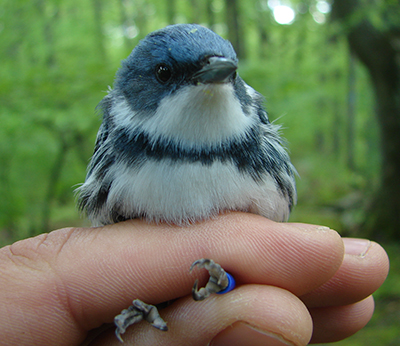 "We were working in southern West Virginia on the effects of mining on songbird populations and we noticed that there were lots of cerulean warblers there," Wood explains about the start of her work with the species. "This was when there wasn't a whole lot known about cerulean warblers and there was a lot of effort trying to figure out what was going on with this bird, including in landscapes heavily impacted by mining. There also were questions about forest management and what could be done that might benefit the birds, which are canopy gap specialists. Working with other research biologists in the Appalachians, we were able to pull together funding for a regional study to evaluate different silvicultural practices commonly used in the region to see if any would help improve habitat for the bird. What level of canopy disturbance can they tolerate or what is optimal forest management for them and what other species can be helped with that process? Through that research and existing information, we developed forest management guidelines that have been implemented throughout the hardwood forests of the eastern U.S. We were able to help a lot of bird species, specifically the cerulean, and give the timber industry advice on best practices, which they have implemented."
"We were working in southern West Virginia on the effects of mining on songbird populations and we noticed that there were lots of cerulean warblers there," Wood explains about the start of her work with the species. "This was when there wasn't a whole lot known about cerulean warblers and there was a lot of effort trying to figure out what was going on with this bird, including in landscapes heavily impacted by mining. There also were questions about forest management and what could be done that might benefit the birds, which are canopy gap specialists. Working with other research biologists in the Appalachians, we were able to pull together funding for a regional study to evaluate different silvicultural practices commonly used in the region to see if any would help improve habitat for the bird. What level of canopy disturbance can they tolerate or what is optimal forest management for them and what other species can be helped with that process? Through that research and existing information, we developed forest management guidelines that have been implemented throughout the hardwood forests of the eastern U.S. We were able to help a lot of bird species, specifically the cerulean, and give the timber industry advice on best practices, which they have implemented."
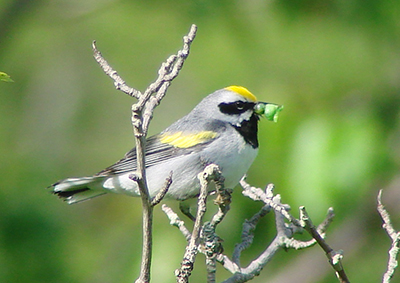 The research on golden-winged warblers, which are the fastest declining early successional songbird, has covered timber harvesting strategies to improve species habitat, habitat management best practices and studies linking breeding and wintering grounds for the species. Projects involved researchers from six states in the central Appalachian region and also some from the Great Lakes region, where there is a large population of the species. The results of the research fed into management guidelines and a status assessment of the species across the entire golden-winged warbler range.
The research on golden-winged warblers, which are the fastest declining early successional songbird, has covered timber harvesting strategies to improve species habitat, habitat management best practices and studies linking breeding and wintering grounds for the species. Projects involved researchers from six states in the central Appalachian region and also some from the Great Lakes region, where there is a large population of the species. The results of the research fed into management guidelines and a status assessment of the species across the entire golden-winged warbler range.
Wood drew on her previous work with surface mining when developing research questions and a team to evaluate the effects of shale gas extraction on bird communities, in particular the Louisiana waterthrush, in forested landscapes. The results of this work on avian response to the landscape change in deciduous forests is used extensively by state, federal and non-government organizations when evaluating environmental effects from energy extraction.
Wood and her collaborators also have extensively studied Allegheny woodrat habitat needs and response to forest management, woodcock habitats, and various raptors, including saw-whet owls.
A recently completed study examined the effects of the pesticide imidacloprid, which is the primary treatment for hemlock woolly adelgid, on terrestrial and aquatic insects and salamanders. The research results will inform future treatment efforts by examining the sublethal effects and bioaccumulation of this pesticide in terrestrial and aquatic ecosystems and organisms.
In addition to her research with the cooperative research unit, Wood is also helping train the next generation of natural resource professionals through the unit's mission focused on graduate education. In her capacity as adjunct professor and in her research, Wood has contributed to the development of nearly 100 graduate students.
"That's actually a big part of the job," Wood says of the mentoring and training of grad students. "I'm not sure how many I have had over the years, but pretty much all of them have gone into some type of teaching, management or research position that deals with conservation of natural resources. It's a weird thought to me, but some of my early students also have students so I am an academic grandmother. Having so many talented students to work with and then seeing them go on and start their own careers has been a really neat part of the job."
Despite all of her research accomplishments and accolades, Wood notes that receiving the Distinguished Alumna Award not only brings her back to her roots but prompted her to look at the impacts of her work collectively.
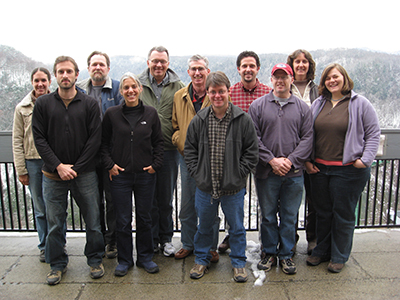 "It is pretty amazing," Wood said. "I was at Purdue so long ago, but that is really where it all started. I didn't even know there was a career like this in natural resources until I went to Purdue. Having an award from where it all started, from a place that is a big part of how I got to where I am, is incredible. It's neat to have your individual project results get used and to be recognized for them. But thinking about all of these efforts and my part in them as well as the students I've worked with and other collaborators, and to have that all pulled together into 40 years of research, counting my graduate years, and being told that it was important work, that is a great feeling."
"It is pretty amazing," Wood said. "I was at Purdue so long ago, but that is really where it all started. I didn't even know there was a career like this in natural resources until I went to Purdue. Having an award from where it all started, from a place that is a big part of how I got to where I am, is incredible. It's neat to have your individual project results get used and to be recognized for them. But thinking about all of these efforts and my part in them as well as the students I've worked with and other collaborators, and to have that all pulled together into 40 years of research, counting my graduate years, and being told that it was important work, that is a great feeling."
Wood was nominated by three of her co-workers at West Virginia University, Dr. Gregory Dahle, Dr. Robert C. Burns and 2020 FNR Lifetime Achievement Award honoree Mary Beth Adams.
"Dr. Wood's contributions to knowledge about wildlife and human interactions, and through her service to her profession and to society, are truly exemplary," the trio stated. "Dr. Wood has a significant body of pioneering research. She is a prolific scientist and exemplifies the ideal of outstanding achievement and service. She is elevating the science and management of wildlife ecology to inform policy and the public. We strongly endorse Dr. Petra Wood as a distinguished alumnus of the Purdue Forestry and Natural Resources Program."
In addition to her work, Wood volunteers with local groups such as the West Virginia Botanic Garden, the Sierra Club and the West Virginia Highlands Conservancy, offering both professional expertise and educational opportunities such as wildflower walks and bird watches. She also enjoys hiking, bike riding and kayaking and can be found out for a short walk in the woods nearly every day or out working in her large flower and vegetable garden. All of which she hopes to eventually be able to participate in more.
From colleagues to former professors and mentors to graduate students to family, Wood is thankful for all of those who have made her distinguished career possible.
"I want to thank everyone I've ever worked with because so many of these projects aren't things I did on my own," Wood stated. "I have worked with so many collaborators on these projects, colleagues from state and federal agencies and from private NGOs. Without all of those wonderful collaborators and the incredibly talented graduate students that worked with me on so many different research questions, this career wouldn't have happened.
"I also thank my family. My parents were very supportive of me going to college and ultimately graduating with a PhD. No one in my family had even gone to college. I especially want to thank my husband, John Wood, for his love and support. He has been here at my side during my whole career lending a hand in so many ways over the years."






